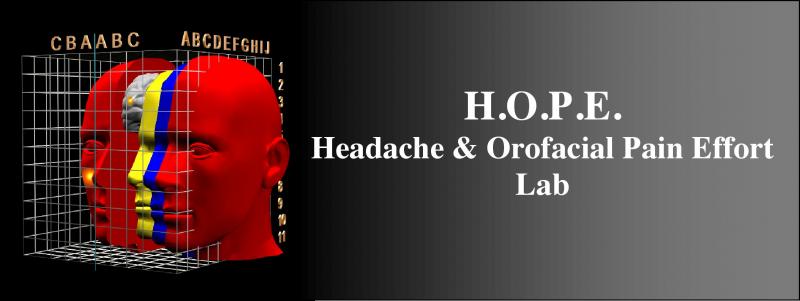Brain scans show dopamine levels fall during migraine attacks
March 29, 2017 | Michigan News
(Headache & Orofacial Pain Effort Lab)
Techno-innovations in pain research, therapeutics, and education.
Directed by Dr. Alexandre F. DaSilva, H.O.P.E. (Headache & Orofacial Pain Effort) is a multidisciplinary collaborative effort to investigate the brain as a research and therapeutic target for chronic trigeminal pain disorders, including primary headaches (e.g. migraine), TMJD and trigeminal neuropathic pain.
The fact that many therapeutic modalities for chronic pain, which focus on peripheral mechanisms, do not provide relief for treatment-resistant patients raises the possibility that the cause for the chronicity of these debilitating disorders may lie in the brain itself. One hypothesis is that functional and structural dysfunction of specific cortical areas (e.g. SI, DLPFC), even at molecular level (e.g. opioidergic and gabanergic mechanisms), may be responsible for the persistence and intensification of the pain suffering.
Together with collaborators from University of Michigan and other academic institutions, we use state-of-the-art neuroimaging techniques (fMRI, PET, MRS, DTI, and MRI-based morphometry) to study neuroplasticity, and to investigate novel therapeutic approaches and mechanisms (e.g. non-invasive brain stimulation) in chronic trigeminal pain disorders.
Investigation and Modulation of the Central Mu-Opioid Mechanism in Migraine (in vivo)
Volunteers needed for a research study using Magnetic Resonance Imaging (MRI) and Positron Emission Tomography (PET) in people who suffer from chronic migraine to identify factors that may be correlated with the severity of migraine attacks. This will also include a non-invasive treatment called high-definition transcranial direct current stimulation (HD-tDCS) in order to study the effects a mild electrical stimulation of the brain may have on migraine-related mechanisms. We are seeking males and females between the ages of 18 and 65 who have chronic migraine. Please fill out this survey to be contacted to join the study. For more information please contact the study team at (734)763-8469 or [email protected].
Explosive Synchronization of Brain Network Activity in Chronic Pain
Aim 3: The purpose of this study is to help researchers learn more about brain networks that may be associated with Fibromyalgia. We are recruiting FEMALES (age 19 - 75) with Fibromyalgia to participate in this study which involves receiving ten non-invasive brain stimulation treatments. Participation includes 15 in-person visits over a 3 month period.
For more information please contact the study team at (734)763-8469 or [email protected]
Please fill out this survey to help evaluate your eligibility for the study.
Visual and Auditory Neuromodulation of Pain Perception - TMD
We are recruiting right handed patients between ages 18-60 with jaw pain or TMD. The purpose of this study is to investigate if mindful breathing can reduce pain perception and modify brain activity. Participants will focus on their breathing while experiencing visual and auditory stimuli or traditional breathing. Some patients will be in a control group, others will participate in a virtual reality experience, while others will practice mindful breathing, a type of meditation. Participation includes up to 7 study visits over a 3 week period.
For more information please contact the study team at (734)763-8469 or [email protected]
Please fill out this survey to help evaluate your eligibility for the study.
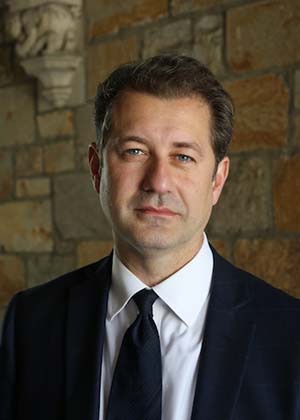
[email protected] | 734-615-3807 | Download CV
Dr. Alexandre DaSilva is a Professor in the Biologic & Materials Sciences Department at the University of Michigan Dental School. He has received his Doctorate in Medical Science (DMSc) degree in Oral Biology with clinical training in trigeminal pain at Harvard University. His thesis subject was on somatotopic (fMRI) activation in the human trigeminal pain pathway. This training was followed by a post-doctoral fellowship on migraine neuroimaging at the Martinos Center for Biomedical Imaging, Massachusetts General Hospital, to investigate subcortical and cortical neuroplasticity in migraine patients. He was also an Instructor in the Psychiatric Department at Harvard University/McLean Hospital, as well as, an Assistant Clinical Investigator at the Forsyth Institute in Boston. During his training, he collaborated with his colleagues on innovative neuroimaging and non-invasive brain stimulation projects for chronic TMJD, trigeminal neuropathic pain and migraine.
He is currently the Director of H.O.P.E. (Headache & Orofacial Pain Effort), which is a multidisciplinary collaborative effort to investigate the brain as a research and therapeutic target for chronic trigeminal pain disorders. The fact that many therapeutic modalities for chronic pain, which focus on peripheral mechanisms, do not provide relief for treatment-resistant patients raises the possibility that the cause for the chronicity of these debilitating disorders may lie in the brain itself. One hypothesis is that functional and structural dysfunction of specific cortical areas (e.g. SI, DLPFC), even at a molecular level (e.g. opioidergic and gabanergic mechanisms), may be responsible for the persistence and intensification of the pain suffering. Together with collaborators from the University of Michigan and other academic institutions, we use state-of-the-art neuroimaging techniques (fMRI, PET, MRS, DTI, and MRI-based morphometry) to study neuroplasticity, and to investigate novel therapeutic approaches and mechanisms in chronic trigeminal pain disorders, including TMD the main focus.
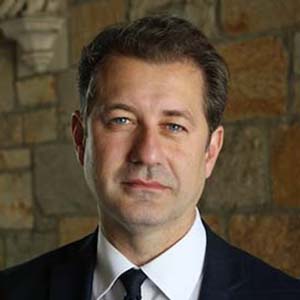
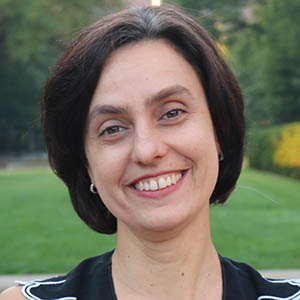

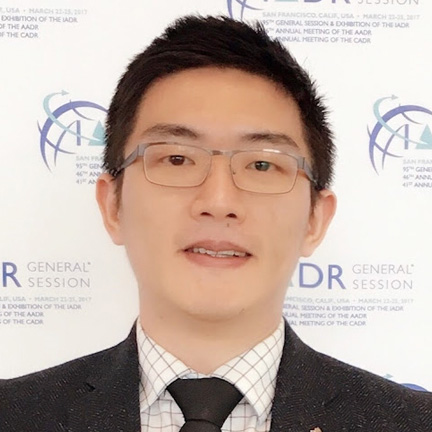
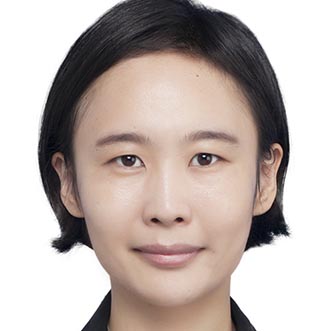
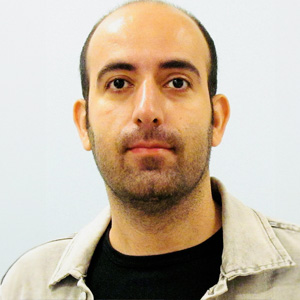
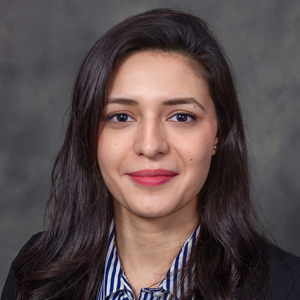








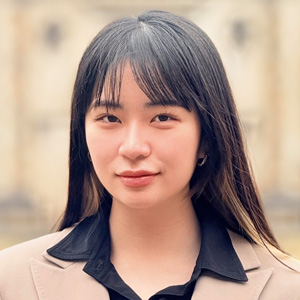
Avni Kinra
Student Volunteer
Lara King
Programmer
Ty Bie
Programmer
Samuel Uribe Botero
Study Coordinator
Suchitra Pudipeddi
Programmer
Amber Fuchs
Sindhu Kannappan
Alexis Barritt
Student Volunteer
Nupur Shah
Student Volunteer
Susie Davenport
Graduate Resident
Hafsa Affendi
Private practice
Sindhu Kannappan, DDS
Graduate Resident
Chidinma Okafor
Graduate Resident Orthodontics MS
Thiago Nascimento, DDS, MMedSc, MS
Private Practice
Ifeyinwa Arinze
MFA Student, NYU Tisch School of the Arts
Conrad Chrabol, MD
Medical University of Warsaw
Misty DeBoer
Communications Coordinator - Institute for Central American Development Studies (ICADS) - Costa Rica
Isaac Dripps, PhD
Research Fellow
Andrea Kadima
Chelsea Cummiford Kaplan, PhD
Research Investigator
Leen Khatib, DDS
Private practice
Nellie Kippley
Nephrology Physician Assistant
Michael Krivichkin
Sarah Lucas
Ilkka Martikainen, MD, PhD
University of Turku, Finland
Alexandra Martella, DDS, MS
Private practice
JJ Ubonwan Sae-Ung, DDS
Private practice
David Schwitzer, DDS
OMFS Resident, UT Southwestern
Rebecca Toback
Medical student, University of Michigan
Hendrik Van Holsbeeck, DDS
Private practice
Nathan Wigington, DDS
Private practice
Mary Catherine Bender, DDS
Graduate Orthodontics Resident
Brenda de Souza Moura, DDS, MS
Research Assistant
Manyoel Lim, PhD
Research Fellow
Hassan Jassar, PhD
Research Fellow
Dalya Saleem, BSPH
Clinical Subjects Coordinator
Danielle Kristal
Graduate Resident
Vivian Finotti Ribeiro Oliveira
GVisiting Scholar, Nurse/Postdoctoral Fellow at the Federal University of São Paulo (UNIFESP)
March 29, 2017 | Michigan News
CBS News: Migraines prompt colorful tweets.
Plus coverage in: Metro, Slate, Financial Express, NBC, CBS, BBC, Scientific American Mind Magazine, Reuters, Forbes, Washington Post, The Guardian, The Telegraph, CBC, Medical News Today, Delhi Daily News, Free Press Journal, The News International, RedOrbit, Detroit Free Press, UPI, and others.
2010 Science News Magazine: “Why It’s So Hard to Tell Which Tooth Has the Ache” by Sarah Sanders.
2012 Science Daily: “Technology eases migraine pain in the deep brain”
2014 Los Angeles Times: “Tweeting a Killer Migraine in Real Time” by Mary MacVean
2014 USA Today: "Worst: Migraine sufferers share pain on Twitter” by Kim Painter
2014 WDIV, NBC TV Channel affiliate: “Live in the D: Inside U of M's 3D lab” by FrankMcGeorge
2014 Popular Mechanics: “Virtual Surgery: Training Med Students on a 3D Cadaver” by Charles Q. Choi
2014 WWJ Newsradio CBS radio affiliated: “Migraine twitter” by Sean Lee
2001 Globo Reporter (Brazil): “The Brain with Pain.”
2014 Journal da Band (Brazil): “3D Autopsy Helps Future Doctors”
